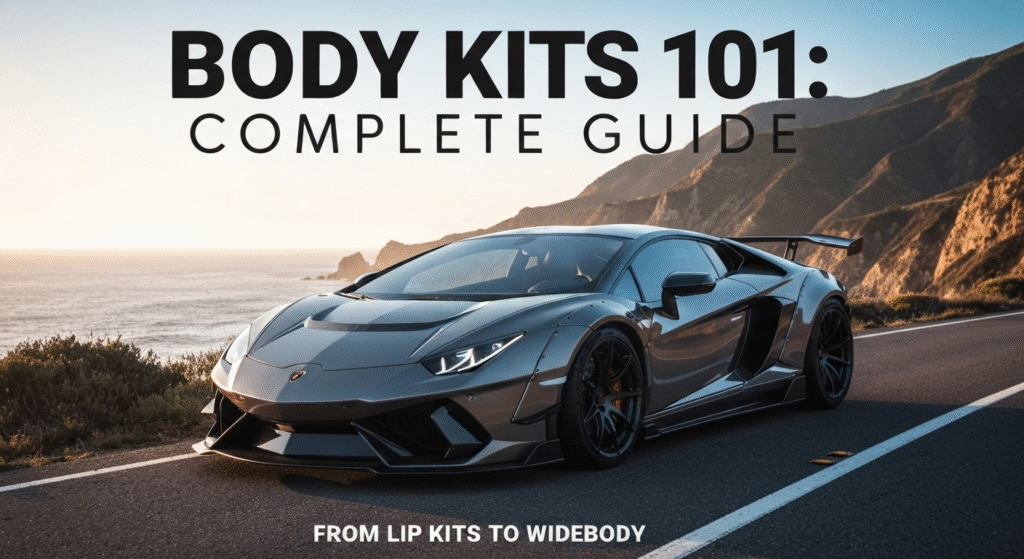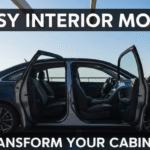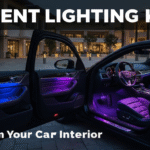Body kits represent one of the most dramatic ways to transform your vehicle’s appearance and performance characteristics. Whether you’re considering a subtle front lip spoiler or planning a complete widebody conversion, understanding the fundamentals of automotive body modifications can save you thousands of dollars and countless headaches.
As someone who has worked in the automotive customization industry for over five years, I’ve witnessed the evolution of body kit technology and installation techniques firsthand. My name is Sharmin, and I’ve guided hundreds of car enthusiasts through their modification journeys, from their first lip kit installation to complex widebody builds that completely reshape their vehicles.
Through my experience working with various manufacturers, installation shops, and individual customers, I’ve learned that successful body kit projects require more than just selecting the right parts. They demand understanding materials, fitment tolerances, installation procedures, and long-term maintenance requirements.
What Are Body Kits and Why Do People Install Them?
Body kits are aftermarket automotive components designed to modify a vehicle’s exterior appearance and aerodynamic properties. These modifications can range from simple additions like front lip spoilers to comprehensive transformations involving fenders, side skirts, rear diffusers, and complete body panel replacements.
The primary motivations for installing body kits include aesthetic enhancement, improved aerodynamic performance, and personal expression. Many enthusiasts seek to create a more aggressive, sporty appearance that reflects their personality and driving style.
From a functional perspective, well-designed body kits can reduce drag, increase downforce, and improve high-speed stability. Professional racing teams have used aerodynamic modifications for decades, and these principles now filter down to street applications.
However, the decision to install a body kit shouldn’t be taken lightly. Quality installations require significant investment in both parts and labor, while poor execution can decrease your vehicle’s value and create safety concerns.
Types of Body Kit Materials: Understanding Your Options
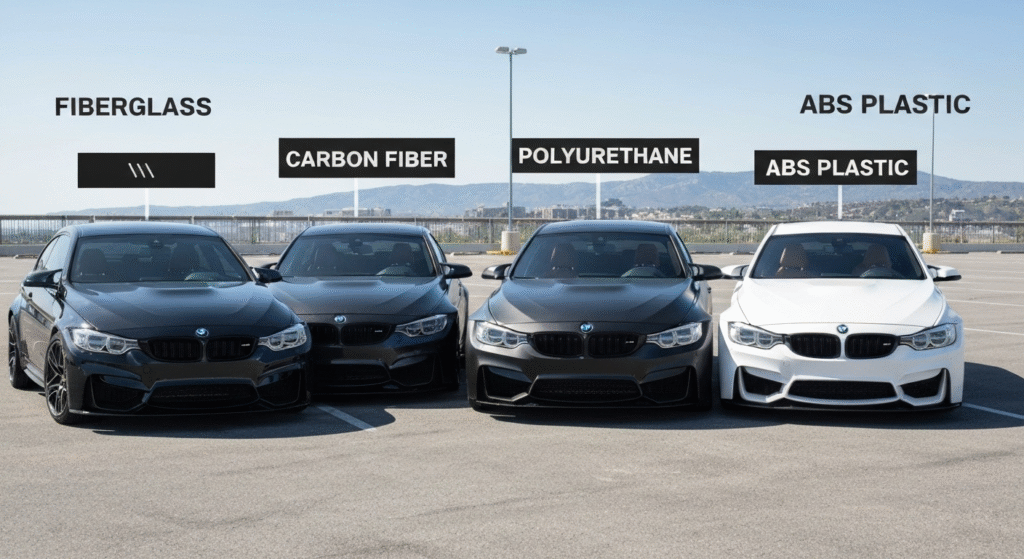
Fiberglass Body Kits
Fiberglass remains the most common material for aftermarket body kits due to its favorable cost-to-performance ratio. This composite material offers excellent moldability, allowing manufacturers to create complex shapes and aggressive designs.
Advantages of Fiberglass:
- Lower initial cost compared to carbon fiber
- Easy to repair when damaged
- Lightweight compared to OEM panels
- Accepts paint well with proper preparation
Disadvantages of Fiberglass:
- More fragile than plastic alternatives
- Requires careful handling during installation
- Can crack under extreme temperature changes
- May require additional reinforcement for daily driving
During my early years in the industry, I worked extensively with fiberglass kits and learned that quality varies significantly between manufacturers. Higher-end fiberglass components use better resin systems and reinforcement materials, resulting in superior durability and finish quality.
Carbon Fiber Components
Carbon fiber represents the premium choice for body kit materials, offering exceptional strength-to-weight ratios and distinctive visual appeal. Real carbon fiber components command higher prices but deliver unmatched performance benefits.
Carbon Fiber Benefits:
- Extremely lightweight construction
- Superior strength and rigidity
- Distinctive woven appearance
- Excellent heat resistance properties
Carbon Fiber Limitations:
- Significantly higher cost
- Difficult and expensive to repair
- Limited color options without paint
- Requires specialized installation techniques
I’ve noticed that many customers initially gravitate toward carbon fiber for its appearance, only to discover that quality varies dramatically. Authentic carbon fiber components use aerospace-grade materials, while cheaper alternatives may use carbon fiber vinyl wraps over fiberglass substrates.
Polyurethane (PU) Body Kits
Polyurethane body kits offer the best balance of durability and practicality for daily-driven vehicles. This flexible plastic material resists impacts better than fiberglass while maintaining reasonable costs.
Polyurethane Advantages:
- Excellent impact resistance
- Flexible material prevents cracking
- Suitable for daily driving conditions
- Good long-term durability
Polyurethane Disadvantages:
- Heavier than fiberglass alternatives
- More expensive than basic fiberglass
- Limited availability for some vehicles
- May require special adhesives for installation
ABS Plastic Options
ABS plastic body kits provide the most affordable entry point into vehicle modification. While not suitable for every application, they offer decent durability for budget-conscious enthusiasts.
MaterialCost RangeDurabilityWeightRepairabilityABS Plastic$GoodHeavyEasyFiberglass$$FairLightModeratePolyurethane$$$ExcellentMediumDifficultCarbon Fiber$$$$GoodVery LightVery Difficult
Lip Kits: The Perfect Starting Point
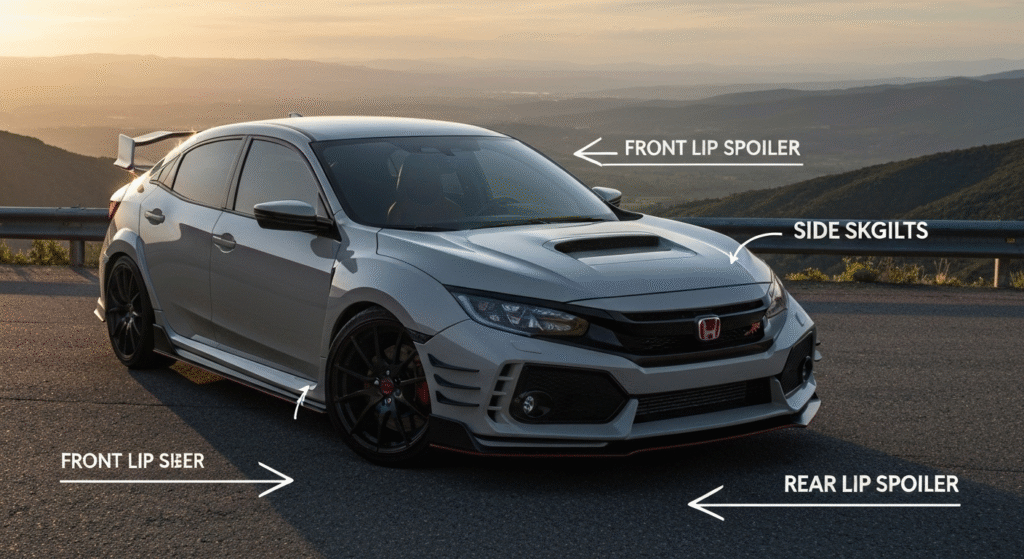
Lip kits represent the ideal introduction to body modifications for several reasons. They’re typically the most affordable option, require minimal installation complexity, and provide immediate visual impact without permanent vehicle modifications.
Front Lip Spoilers
Front lip spoilers attach to the bottom edge of your factory front bumper, creating a lower, more aggressive appearance while potentially improving aerodynamic properties. These components typically mount using existing hardware points or 3M adhesive systems.
Most front lips install within 2-3 hours using basic tools. The process involves cleaning the mounting surface, test-fitting the component, and securing it using the manufacturer’s recommended method. I always recommend dry-fitting components before applying any adhesives or drilling holes.
Side Skirts and Extensions
Side skirts create visual continuity between front and rear modifications while giving the impression of a lowered vehicle. Quality side skirts should align perfectly with existing body lines and maintain proper ground clearance for daily driving.
Professional installation typically costs $200-400 per side, depending on complexity and local labor rates. DIY installation is possible but requires patience and attention to detail, particularly when aligning multiple components.
Rear Lip Spoilers
Rear lips complete the visual transformation while potentially providing functional benefits at higher speeds. These components typically mount to the rear bumper using similar methods to front lips.
When selecting rear lips, consider your driving habits and parking situations. Lower profiles work better for daily drivers, while aggressive designs suit track-focused builds.
Comprehensive Body Kit Systems
Full body kit systems provide complete visual transformations but require significantly more planning, investment, and installation expertise. These kits typically include front bumpers, side skirts, rear bumpers, and various accent pieces.
OEM-Style Kits
OEM-style body kits maintain factory fit and finish standards while providing subtle appearance enhancements. These kits often come from the vehicle manufacturer or authorized partners, ensuring proper fitment and quality.
OEM-Style Kit Benefits:
- Guaranteed fitment accuracy
- Factory-quality materials and finish
- Maintained warranty coverage
- Professional installation support
OEM-Style Kit Limitations:
- Higher cost than aftermarket alternatives
- Limited design variety
- May not provide dramatic visual changes
- Longer delivery times
Aftermarket Complete Systems
Aftermarket body kit manufacturers offer wider design variety and typically lower costs than OEM alternatives. However, quality and fitment can vary significantly between brands.
During my experience with various manufacturers, I’ve learned to identify quality indicators that predict successful installations. Premium kits feature precise mounting points, quality materials, and comprehensive installation instructions.
Quality Indicators to Look For:
- Detailed fitment specifications
- Multiple mounting point options
- Quality control certifications
- Positive customer reviews and testimonials
Custom Fabrication Options
Custom body kits offer unlimited design possibilities but require significant investment and expertise. These projects typically involve working with specialized fabricators to create unique components.
I’ve overseen several custom projects, and successful builds require clear communication between all parties, realistic timelines, and adequate budgets for unexpected complications.
Widebody Conversions: The Ultimate Transformation
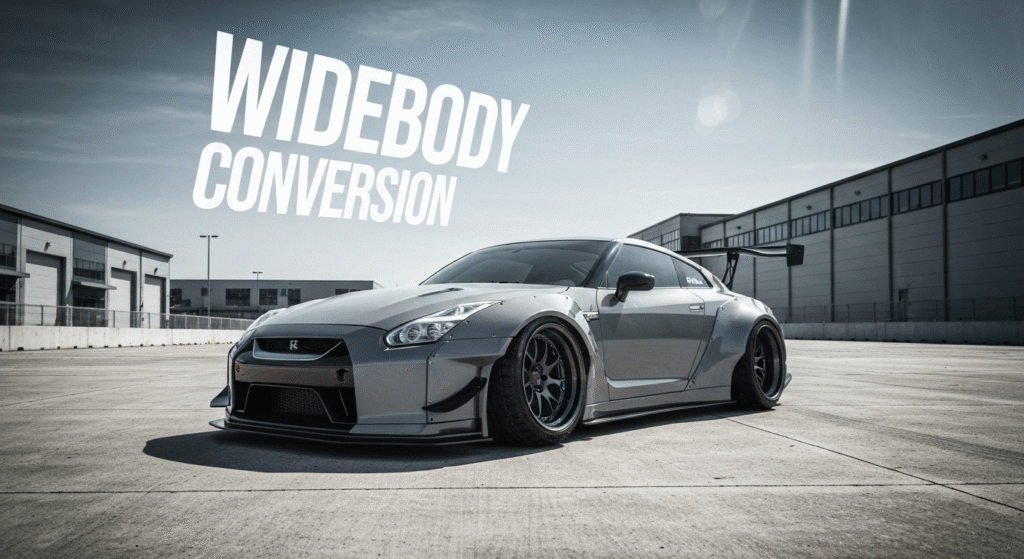
Widebody conversions represent the most dramatic form of automotive modification, typically involving fender replacements or extensions that accommodate wider wheels and tires. These projects require extensive planning and often permanent vehicle modifications.
Bolt-On Widebody Systems
Modern bolt-on widebody kits offer dramatic transformations without irreversible modifications. These systems typically use existing mounting points and can be removed if necessary.
Popular Bolt-On Systems:
- Rocket Bunny/Pandem kits
- Liberty Walk designs
- Clinched Flares
- Artisan Spirits components
Installation complexity varies significantly between designs. Simpler systems may install in a weekend, while complex kits require professional installation and paint work.
Fender Flare Extensions
Fender flares provide a more subtle widebody appearance while maintaining daily drivability. These components typically bolt or rivet to existing fender edges.
I’ve installed numerous flare systems and learned that proper preparation is crucial for long-term success. This includes thorough cleaning, precise measurement, and adequate sealing to prevent water intrusion.
Full Fender Replacements
Complete fender replacements offer the most dramatic transformations but require permanent vehicle modifications. These projects often involve cutting original body panels and welding new components.
Fender Replacement Considerations:
- Professional installation recommended
- Permanent modification affects resale value
- Requires paint and bodywork
- May affect insurance coverage
Installation Process and Professional vs DIY
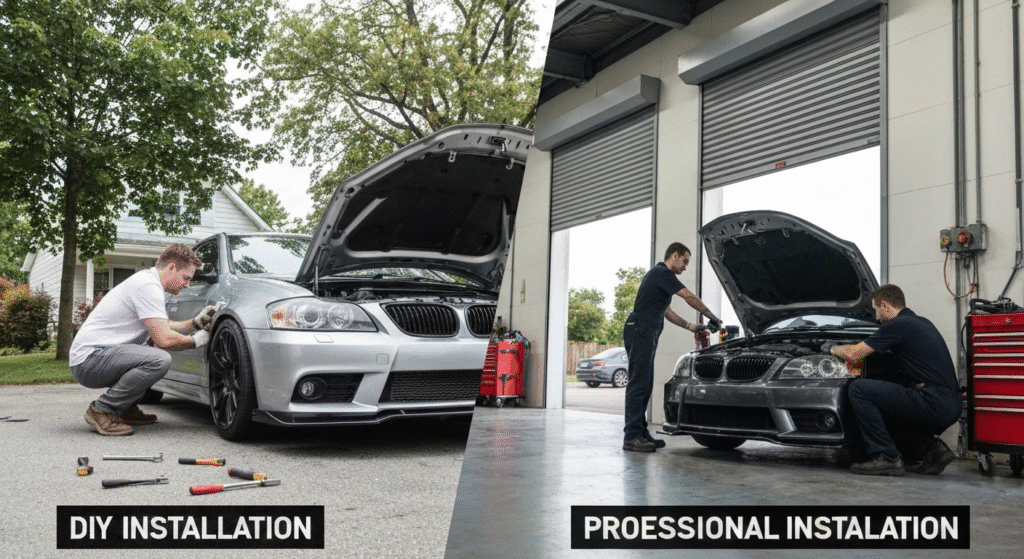
DIY Installation Guidelines
Simple lip kits and basic modifications can be installed by enthusiastic DIYers with proper tools and patience. Successful DIY installations require adequate workspace, quality tools, and realistic time expectations.
Essential Tools for DIY Installation:
- Complete socket and wrench sets
- Electric drill with various bits
- Measuring tools and levels
- Cutting tools for minor trimming
- Safety equipment including gloves and eye protection
When to Choose Professional Installation
Complex body kits, paint work, and permanent modifications typically require professional expertise. Professional installers have specialized tools, experience with fitment issues, and insurance coverage for potential problems.
I always recommend professional installation for projects involving:
- Paint and bodywork requirements
- Permanent vehicle modifications
- Complex alignment procedures
- Expensive component installations
Cost Considerations
Installation costs vary significantly based on kit complexity, local labor rates, and additional services required. Basic lip kit installations may cost $200-500, while complete widebody conversions can exceed $5,000-10,000 including paint and bodywork.
Installation TypeDIY TimeProfessional CostSkill Level RequiredFront Lip2-4 hours$150-300BeginnerSide Skirts4-6 hours$300-600IntermediateComplete Kit8-16 hours$1,500-3,000AdvancedWidebody ConversionN/A$5,000-10,000+Professional Only
Maintenance and Long-Term Care
Body kit maintenance extends far beyond the initial installation. Proper care ensures your investment maintains its appearance and functionality over time.
Regular Cleaning Procedures
Modified vehicles require more attention during cleaning due to increased surface area and complex geometries. Lower components accumulate more road debris and require frequent attention.
I recommend establishing a regular cleaning routine that addresses both visible surfaces and hidden areas where debris can accumulate. This includes wheel wells, underneath lips and skirts, and around mounting hardware.
Damage Prevention Strategies
Lower body components face increased risk of damage from road debris, parking situations, and weather conditions. Protective measures can significantly extend component lifespan.
Damage Prevention Tips:
- Avoid steep driveways and parking curbs
- Install front splitter support rods where applicable
- Use car dollies for storage and transport
- Apply protective films to high-wear areas
Repair and Refinishing
Even with careful maintenance, body kit components may require repair or refinishing over time. Understanding repair options helps maintain your investment’s value and appearance.
Minor fiberglass damage can often be repaired using standard bodywork techniques, while polyurethane components may require specialized repair methods. Carbon fiber repairs typically require professional expertise and may not be cost-effective for extensive damage.
Common Problems and Solutions
Fitment Issues
Poor fitment represents the most common body kit problem, often resulting from manufacturing tolerances, shipping damage, or installation errors. Quality manufacturers provide specific fitment tolerances and adjustment procedures.
When encountering fitment issues, I always start with dry-fitting all components before making any permanent modifications. This process identifies potential problems early and allows for corrections before point-of-no-return installations.
Paint Matching Challenges
Achieving perfect paint matches between body kits and factory panels requires professional expertise and proper materials. Color variations can occur due to age, UV exposure, and manufacturing differences.
Paint Matching Best Practices:
- Use factory paint codes when available
- Allow for blending into adjacent panels
- Consider full-vehicle repainting for dramatic modifications
- Factor paint costs into project budgets
Hardware and Mounting Problems
Loose or failed mounting hardware can lead to expensive damage and safety concerns. Regular inspection of all mounting points should be part of your maintenance routine.
I’ve seen numerous cases where inadequate hardware led to component loss during driving. Always use manufacturer-specified hardware and inspect mounting points regularly, especially after driving in harsh conditions.
Performance Impact and Aerodynamic Considerations
Aerodynamic Benefits
Well-designed body kits can provide measurable aerodynamic improvements, particularly at higher speeds. Front splitters can increase downforce, while rear spoilers and diffusers can reduce drag and improve stability.
However, many aftermarket body kits prioritize appearance over aerodynamic function. Genuine performance benefits typically require careful design and often compromise daily drivability through reduced ground clearance and increased wind noise.
Handling Effects
Body kit modifications can affect vehicle handling through several mechanisms. Added downforce can improve high-speed stability but may increase tire wear and reduce fuel economy.
Lower ride heights associated with aggressive body kits can improve handling by lowering the center of gravity but may negatively impact ride quality and practicality.
Fuel Economy Impact
Most body kit installations have minimal impact on fuel economy, though aggressive modifications with significant drag increases can measurably affect efficiency. The visual impact typically outweighs any performance penalties for most enthusiasts.
Legal and Insurance Considerations
State and Local Regulations
Body kit modifications must comply with local vehicle safety and emission regulations. Some jurisdictions have specific requirements regarding ground clearance, lighting visibility, and structural modifications.
Before beginning any major modification project, research local regulations and consider potential impacts on vehicle registration and inspection requirements.
Insurance Implications
Significant vehicle modifications should be reported to insurance companies to ensure proper coverage. Some modifications may increase premiums, while others might void coverage entirely.
I always recommend discussing modification plans with insurance providers before beginning work to avoid coverage surprises later.
Resale Value Effects
Body kit modifications can significantly impact resale value, both positively and negatively depending on execution quality and buyer preferences. Professional installations with quality components typically maintain value better than budget modifications.
Consider your long-term vehicle plans when selecting body kit components and installation methods. Reversible modifications preserve more options than permanent changes.
Frequently Asked Questions
How much should I budget for a complete body kit installation? Budget $3,000-8,000 for quality components and professional installation, including paint work. Basic lip kits start around $500-1,500 installed, while widebody conversions can exceed $15,000.
Can I install a body kit without affecting my warranty? Most body kit installations won’t void your entire warranty, but they may affect coverage for related components. Consult your dealer before making modifications to understand potential impacts.
How do I know if a body kit will fit my specific vehicle? Research manufacturer fitment specifications, read customer reviews, and consider purchasing from companies with good return policies. Professional consultation can help identify potential fitment issues.
What’s the difference between replica and authentic body kits? Authentic kits come from original designers with proper licensing and quality control. Replicas may offer similar appearance at lower costs but often feature reduced quality materials and fitment accuracy.
Conclusion
Body kit modifications offer exciting opportunities to personalize your vehicle and express your automotive passion. Success requires careful planning, realistic budgeting, and understanding the long-term implications of your choices.
Whether you’re considering a simple lip kit or planning a complete widebody transformation, the key lies in selecting quality components, professional installation when needed, and commitment to proper maintenance. My five years of experience in this industry has taught me that the most satisfied customers are those who do their research, set realistic expectations, and work with reputable suppliers and installers.
Remember that body kit modifications should enhance your enjoyment of your vehicle while maintaining safety and functionality. Take time to plan your project thoroughly, budget appropriately, and don’t rush the process. The best modifications are those that provide years of satisfaction and reflect your personal automotive vision.

